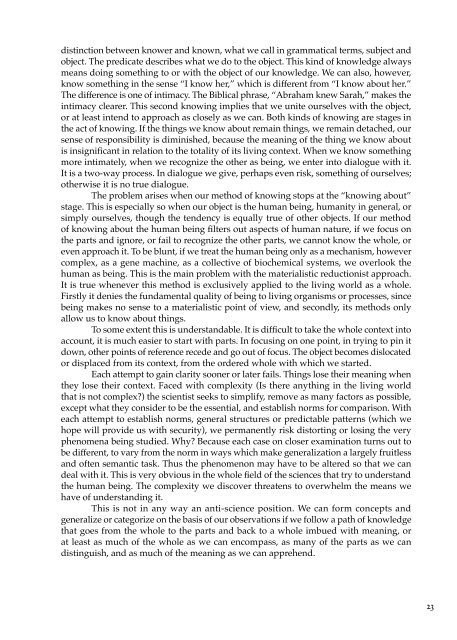The Spirit in Human Evolution - Waldorf Research Institute
The Spirit in Human Evolution - Waldorf Research Institute
The Spirit in Human Evolution - Waldorf Research Institute
Create successful ePaper yourself
Turn your PDF publications into a flip-book with our unique Google optimized e-Paper software.
dist<strong>in</strong>ction between knower and known, what we call <strong>in</strong> grammatical terms, subject and<br />
object. <strong>The</strong> predicate describes what we do to the object. This k<strong>in</strong>d of knowledge always<br />
means do<strong>in</strong>g someth<strong>in</strong>g to or with the object of our knowledge. We can also, however,<br />
know someth<strong>in</strong>g <strong>in</strong> the sense “I know her,” which is different from “I know about her.”<br />
<strong>The</strong> difference is one of <strong>in</strong>timacy. <strong>The</strong> Biblical phrase, “Abraham knew Sarah,” makes the<br />
<strong>in</strong>timacy clearer. This second know<strong>in</strong>g implies that we unite ourselves with the object,<br />
or at least <strong>in</strong>tend to approach as closely as we can. Both k<strong>in</strong>ds of know<strong>in</strong>g are stages <strong>in</strong><br />
the act of know<strong>in</strong>g. If the th<strong>in</strong>gs we know about rema<strong>in</strong> th<strong>in</strong>gs, we rema<strong>in</strong> detached, our<br />
sense of responsibility is dim<strong>in</strong>ished, because the mean<strong>in</strong>g of the th<strong>in</strong>g we know about<br />
is <strong>in</strong>significant <strong>in</strong> relation to the totality of its liv<strong>in</strong>g context. When we know someth<strong>in</strong>g<br />
more <strong>in</strong>timately, when we recognize the other as be<strong>in</strong>g, we enter <strong>in</strong>to dialogue with it.<br />
It is a two-way process. In dialogue we give, perhaps even risk, someth<strong>in</strong>g of ourselves;<br />
otherwise it is no true dialogue.<br />
<strong>The</strong> problem arises when our method of know<strong>in</strong>g stops at the “know<strong>in</strong>g about”<br />
stage. This is especially so when our object is the human be<strong>in</strong>g, humanity <strong>in</strong> general, or<br />
simply ourselves, though the tendency is equally true of other objects. If our method<br />
of know<strong>in</strong>g about the human be<strong>in</strong>g filters out aspects of human nature, if we focus on<br />
the parts and ignore, or fail to recognize the other parts, we cannot know the whole, or<br />
even approach it. To be blunt, if we treat the human be<strong>in</strong>g only as a mechanism, however<br />
complex, as a gene mach<strong>in</strong>e, as a collective of biochemical systems, we overlook the<br />
human as be<strong>in</strong>g. This is the ma<strong>in</strong> problem with the materialistic reductionist approach.<br />
It is true whenever this method is exclusively applied to the liv<strong>in</strong>g world as a whole.<br />
Firstly it denies the fundamental quality of be<strong>in</strong>g to liv<strong>in</strong>g organisms or processes, s<strong>in</strong>ce<br />
be<strong>in</strong>g makes no sense to a materialistic po<strong>in</strong>t of view, and secondly, its methods only<br />
allow us to know about th<strong>in</strong>gs.<br />
To some extent this is understandable. It is difficult to take the whole context <strong>in</strong>to<br />
account, it is much easier to start with parts. In focus<strong>in</strong>g on one po<strong>in</strong>t, <strong>in</strong> try<strong>in</strong>g to p<strong>in</strong> it<br />
down, other po<strong>in</strong>ts of reference recede and go out of focus. <strong>The</strong> object becomes dislocated<br />
or displaced from its context, from the ordered whole with which we started.<br />
Each attempt to ga<strong>in</strong> clarity sooner or later fails. Th<strong>in</strong>gs lose their mean<strong>in</strong>g when<br />
they lose their context. Faced with complexity (Is there anyth<strong>in</strong>g <strong>in</strong> the liv<strong>in</strong>g world<br />
that is not complex?) the scientist seeks to simplify, remove as many factors as possible,<br />
except what they consider to be the essential, and establish norms for comparison. With<br />
each attempt to establish norms, general structures or predictable patterns (which we<br />
hope will provide us with security), we permanently risk distort<strong>in</strong>g or los<strong>in</strong>g the very<br />
phenomena be<strong>in</strong>g studied. Why? Because each case on closer exam<strong>in</strong>ation turns out to<br />
be different, to vary from the norm <strong>in</strong> ways which make generalization a largely fruitless<br />
and often semantic task. Thus the phenomenon may have to be altered so that we can<br />
deal with it. This is very obvious <strong>in</strong> the whole field of the sciences that try to understand<br />
the human be<strong>in</strong>g. <strong>The</strong> complexity we discover threatens to overwhelm the means we<br />
have of understand<strong>in</strong>g it.<br />
This is not <strong>in</strong> any way an anti-science position. We can form concepts and<br />
generalize or categorize on the basis of our observations if we follow a path of knowledge<br />
that goes from the whole to the parts and back to a whole imbued with mean<strong>in</strong>g, or<br />
at least as much of the whole as we can encompass, as many of the parts as we can<br />
dist<strong>in</strong>guish, and as much of the mean<strong>in</strong>g as we can apprehend.<br />
23
















